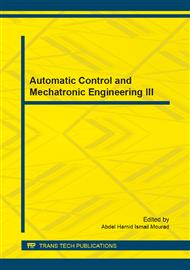[1]
D. Zheng. Linear System Theory. [2nd ed], Beijing: Tsinghua University Press, 2002: 1-4.
Google Scholar
[2]
Levis, A. Challenges to control: A collective view-Report of the workshop held at the University of Santa Clara on September 18-19, 1986. Automatic Control, IEEE Transactions on 32. 4 (1987): 275-285.
DOI: 10.1109/tac.1987.1104602
Google Scholar
[3]
G. Zheng, M. Tan, Y. Song. Research on hybrid systems: A survey. Control Decision. 2004, 19(1): 7-12.
Google Scholar
[4]
Y. Ma, X. Wang, A. Liu, et al. Hybrid dynamic system and its application in power system. J Tianjin Normal Univ (Nat Sci Ed). 2006. 26(4): 70-74.
Google Scholar
[5]
Y. W Mo, D. Xiao. Overview of hybrid dynamic system and its application. Control Theory A. 2002, 19(1): 2-9.
Google Scholar
[6]
Y. Liang, W. Cheng, H. Jiao, et al. Modeling of heating systems based on hybrid automaton and fuzzy control. Electr Eng. 2004, (04): 74-77.
Google Scholar
[7]
M. Dong, T. Wu. Applying learning automation on hybrid system switching control. Control Theory A. 2003, 20(1): 154-157.
Google Scholar
[8]
W. Liao, T. Gu, W. Li, et al. Modeling and scheduling for fuzzy flexible manufacturing system based on hybrid Petri net. Comput Integr Manuf Syst. 2008, 14(11): 2134-2141.
Google Scholar
[9]
W. Liao, T. Gu. Modeling and control for hybrid system based on general hybrid Petri nets. Control Decision. 2007, 22(4): 366-372.
Google Scholar
[10]
Bemporad, M. Morari. Control of systems integrating logic, dynamics, and constraints. Automatica. 1999, 35(3): 407-427.
DOI: 10.1016/s0005-1098(98)00178-2
Google Scholar
[11]
J. Chen, Hybrid Petri nets based modeling of hybrid systems and its application in industry. Beijing Univ of Chem Technol. 2004, 3.
Google Scholar
[12]
Sun Z, Ge S. . Analysis and synthesis of switched linear control systems. Automatica. 2005, 41(2): 181-195.
DOI: 10.1016/j.automatica.2004.09.015
Google Scholar
[13]
X. Xu, P J. Antsaklis. Optimal control of switched autonomous systems. Decision and Control. 2002, P 41st IEEE Conference on IEEE, 2002, 4: 4401-4406.
DOI: 10.1109/cdc.2002.1185065
Google Scholar
[14]
H M. Paynter. Generalizing the concepts of power transport and energy ports for system engineering. ASME Presented at the 1958 Annual Meeting New York. NY (1958).
Google Scholar
[15]
Branicky M S. Stability of switched and hybrid systems. Decision and Control. P 33rd IEEE Conference IEEE, 1994, 4: 3498-3503.
DOI: 10.1109/cdc.1994.411688
Google Scholar
[16]
G. Davrazos, N T. Koussoulas. A review of stability results for switched and hybrid systems. P 9th Mediterr Conference on Control and Automation. (2001).
Google Scholar
[17]
A N. Michel, B. Hu Towards a stability theory of general hybrid dynamical systems. Automatica. 1999, 35(3): 371-384.
DOI: 10.1016/s0005-1098(98)00165-4
Google Scholar
[18]
X. Li, H. Yue, D. Gao. The advances in research on the theory of the hybrid system for the new generation complex industry control. Control Instrum Chem Ind, 2001, 28(5): 1-8.
Google Scholar
[19]
Z. Wang, S. Fei, C. Feng. Optimal control design for a class of switching hybrid systems. J Southeast Univ (Nat Sci Ed). 2002, 32(3): 495-499.
Google Scholar
[20]
Z. Yin, P. Li, C. Gao. Study on optimal control of switching systems and characteristic disparity. J Zhejiang Univ (Eng Sci). 2002, 36(2): 114-118.
Google Scholar
[21]
H. Zhai, H. Su, L. Dong, et al. Study on optimal control strategy for a class of piecewise linear hybrid systems. Control Decision. 2002, 17(6): 863-866, 875.
Google Scholar
[22]
WANG Yuhong, HUANG Dexian, GAO Dongjie, et al. Hybrid method to handle feasibility and constraint prioritization issues in predictive control. Control Decision. 2004, 19(8): 847-851.
Google Scholar
[23]
X. Zhao, Y. Chen. Traffic light control method for a single intersection based on hybrid systems theory. J Beijing Univ Technol. 2004, 30(4): 412-416.
Google Scholar
[24]
J A. Stiver, P J. Antsaklis, M D. Lemmon. A logical DES approach to the design of hybrid control systems. Math Comp Model. 1996, 23(11): 55-76.
DOI: 10.1016/0895-7177(96)00064-7
Google Scholar
[25]
P J G. Ramadge, W M. Wonham. The control of discrete event systems. P Ieee. 1989, 77(1): 81-98.
DOI: 10.1109/5.21072
Google Scholar
[26]
C. Zhang. Synthesis on the Petri net controller for a class of hybrid systems. J Northwest Insti Textile Sc Technol. 1997, 11(3): 248-251.
Google Scholar
[27]
R. Cao, H. Li, H. Li. Optimization research of hybrid system based on Petri net. Control Autom. 2005, 21(1): 27-28.
Google Scholar
[28]
N. Chabrier-Rivier, M. Chiaverini, V. Danos, et al. Modeling and querying bimolecular interaction networks. Theor Comput Sci. 2004, 325(1): 25-44.
DOI: 10.1016/j.tcs.2004.03.063
Google Scholar


